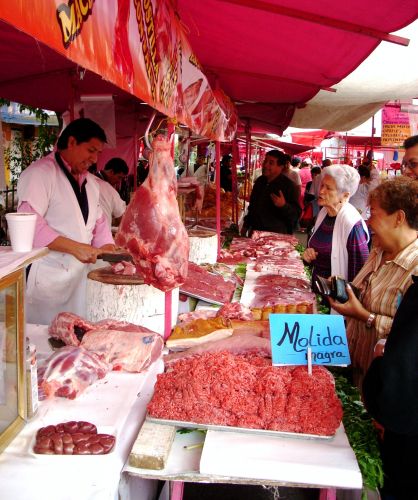
Virtually every neighborhood in Mexico City has a tianguis, also known as a “market on wheels” – a once-a-week event in which vendors are sanctioned to invade and occupy several streets, where they set up stalls with metal poles and wooden planks under pink plastic tarpaulins. Mostly they sell fresh fruits and vegetables but there is also cooked food and all manner of tchotchkes: cookware, toys, clothes, blankets, and pirated CDs and DVDs.
In a typical tianguis there are two or three lanes of stalls, and the customers walk in the limited space in between. By noon, when shoppers have arrived en masse, movement can be painstakingly slow. Among the clients, merchants without stands sinuously circulate on foot, displaying their wares from boxes strapped around their shoulders like cigarette girls. In this fashion, a man with a black beret and a gray beard sells Argentine empanadas. Another announces sticky candies called muéganos in a growly singsong, while another, with slick hair and a pencil moustache, offers heads of garlic, a few fresh herbs, boxes of toothpicks and matches.
Like many of the tianguis merchants, this man is not above seduction, blackmail or guilt trips to induce people to buy his wares. He will begin by pointing out how large, round and fresh his heads of garlic are on that particular Sunday. If you tell him you still have garlic that you bought from him the previous week, he’ll say, “Don’t punish me. Buy some for your mother-in-law.” If you remind him that you are unmarried, he will sigh sigh and say, “I never intended to be here bothering nice people like you. I wish that I could have had an education, so I could be doing something more useful.”
Such tactics are common at the tianguis. There is a stand where a young man with a pompadour sells cantaloupes. If I ask for one melon, he is always quick to prod me to acquire another for my mother, wife, sister, mother-in-law, etc. At this point, I have told him I live alone frequently enough so that he now remembers, and instead suggests that I buy more melons for my girlfriends – real, imagined or potential – advising that an extra cantaloupe in the house could be a useful seduction technique, or even an aphrodisiac. If I insist that I only want one, he tells me he has eight children. (He is no older than 25.) Should I decide I want two, he will then whisper in my ear that he will sell me a third at half price. If I refuse to budge, he looks at me as if my limited melon consumption is a colossal disappointment, a broken promise.
-- excerpted from First Stop in the New World: Mexico City, The Capital of the 21st Century







